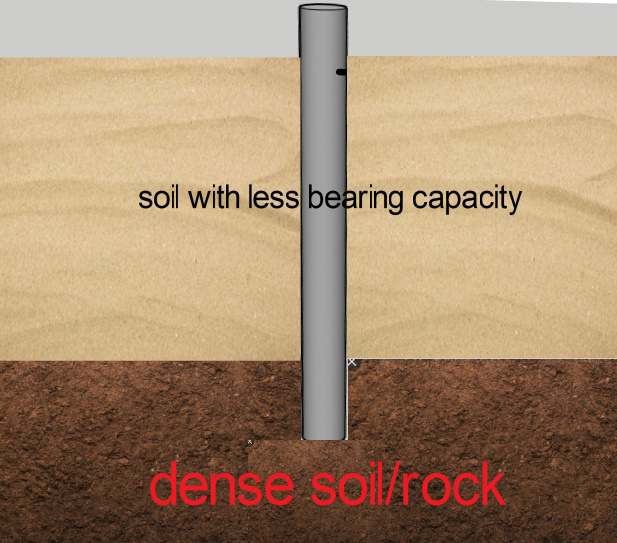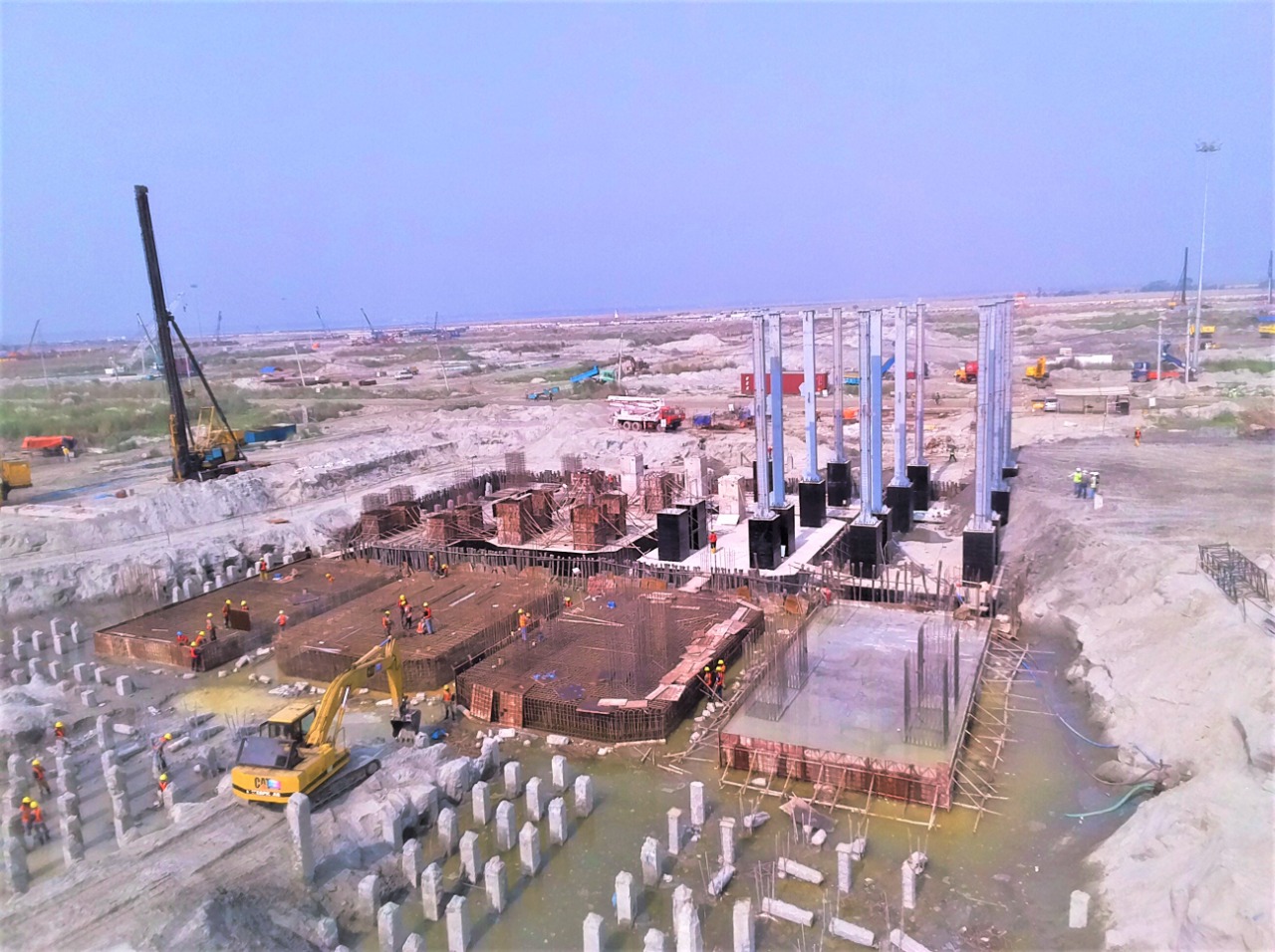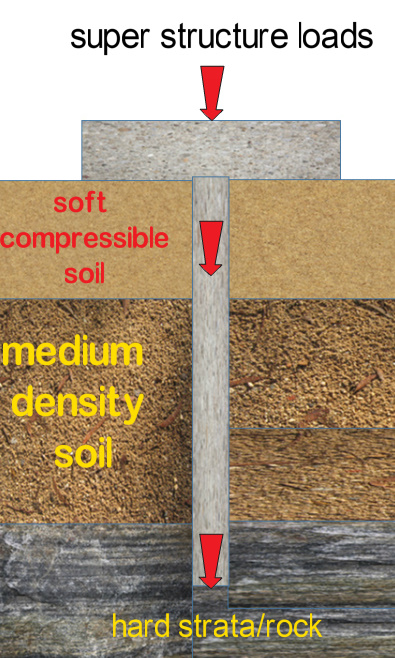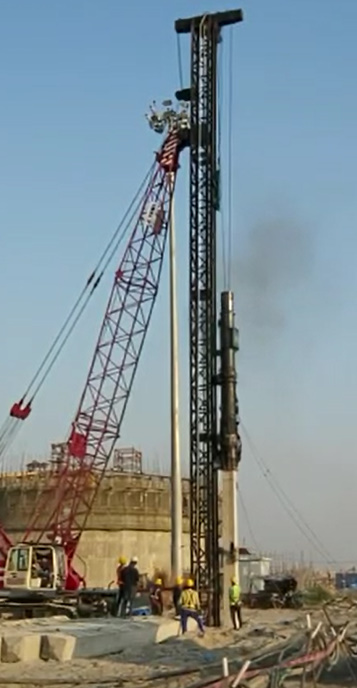WHAT IS A DEEP FOUNDATION
<p class="has-text-align-justify" style="font-size:18px" value="<amp-fit-text layout="fixed-height" min-font-size="6" max-font-size="72" height="80">The foundations having the depth more than the width are called deep foundations. Deep foundations are proposed when the sub soil strata lacks the safe bearing capacity to handle the loads induced by the structure. In such a case the founding level of the foundations are moved to a deeper area with required bearing capacity. The loads on the structure are transferred vertically into the ground.TYPES OF DEEP FOUNDATIONS
- a) PILE FOUNDATION
- b) PIER FOUNDATION
- C) CAISSON OR WELL FOUNDATION
PILE FOUNDATION
Pile foundations are long slender members, which can be concrete, steel or any other material used for transferring the loads of a structure when the subsoil lacks the bearing capacity . The pile foundations transfer the load vertically through the less denser top layer to a high denser soil/rock layer which can negotiate the loads without failure.

CHOICE OF PILE FOUNDATION
Pile foundations are preferred
a) When the groundwater table is very high and other types of open foundations require huge dewatering by well point or deep bore well method which turns out to be quite expensive and not feasible.
b) When heavy and non uniform distribution of loads from the superstructure which causes unequal settlements in open foundations.
c) When the low soil bearing capacity and site conditions tends to make the design of shallow foundations very conservative and uneconomical.
d) When the settlement of soil exceeds the permissible limit while designing a shallow foundation.
e) When the chances of soil washing or scouring away from the foundation sides may happen due to the presence of any underground systems , river or canal nearby.
f) When any type of soil excavation is impossible due to very poor soil strata .
CLASSIFICATION OF PILES BASED ON FUNCTION/LOAD TRANSFER
- a) END BEARING PILES
- b) FRICTION PILES
- c) FRICTION CUM BEARING PILES
- d) BATTER PILE
- e) ANCHOR PILE
- f) SHEET PILE

END BEARING PILES
A bearing pile is a slender member/ column which transmits vertically all loads coming from the super structure. It is transmitted through a lower density weak layer of soil to a denser strata much below the ground which is capable of negotiating the loads. The pile acts as a column member which transfers the loads to the bearing strata.
FRICTION PILES
This type of pile is used when a suitable strata for negotiating the loads are available at a very deeper area and taking piles to that depth is not economically feasible. Friction piles utilises the shear stresses/skin friction along the surface of the pile. The load transfer is done through the frictional resistance between the pile surface and the surrounding soil. The total surface area of the pile is involved in the load transfer process. Greater the embedded length more is the load carrying capacity of the pile. Load carrying capacity of pile is directly proportional to its length.
FRICTION CUM END BEARING PILES

These type of piles negotiate the loads through the combined action of end bearing and skin friction . In this case the piles can be terminated in a medium or stiff clay rather than resting on a hard strata. These types of piles are preferred and considered economical hence it is the most commonly used type of pile foundation.
CLASSIFICATION BASED ON CONSTRUCTION METHODS
The execution of piling is done in two methods
- a) DRIVEN OR DISPLACEMENT METHOD
- b) BORED OR REPLACEMENT METHOD
DRIVEN OR DISPLACEMENT PILES



In this method the piles are driven into the soil/sand which causes lateral displacement of soil and hence it is called displacement piles. Displacement piles are basically designed to be installed without removal of soil. Special equipment are used to drive the piles and displace soil laterally. Depending on situations these types of piles are preferred over bored piles.
BORED OR REPLACEMENT PILES
In this type of foundation bores of required diameter is made and are filled using RCC. It can be a cased or uncased types depending on the collapsible nature of the soil.
CLASSIFICATION BASED ON MATERIALS
- a) TIMBER PILES
- b) STEEL
- c) CONCRETE
- d) COMPOSITE PILES

TIMBER PILES
The timber piles are sharpened logs obtained from trees like sal, teak, deodar, babul, etc. These piles are used in water and can resist sea water better than other piles. These piles are basically friction piles and are driven into the ground. The timber pile length varies from 20-25 mtr and is designed for a load of around 20 t.
Advantages of timber piles
a) Timber piles are available in varied sizes and is cheaper than any other type of piles.
b) It is easy to install and can be cut into any size as per the requirements.
c) Timber piles is more reliable in marine works.
d) Timber piles doesn’t decay even when submerged in water for a prolonged time.
Disadvantages of timber piles
a) It is difficult to get Straight and long timber piles.
b) Timber piles may not pass through all strata. It is difficult to drive piles in hard and dense strata.
c) Timber piles can be used only as friction piles and not as end bearing piles. Splicing of a timber pile is difficult.
d) As a prevention against possible decay timber piles has to be treated with preservatives.
STEEL PILES

Steel piles may be of H-section or hollow pipe (Fig) . They can be used for an optimum length of 20-40 mtr. The size can be upto 600 mm dia pipes and can also done using HP sections having the same flange and web width as shown in the fig. These piles are mostly designed as end bearing piles . These piles are driven as open ended or closed ended . The closed ended pile shall be filled with concrete.
Advantages of steel piles
Steel piles are very easy to install. Due to their less cross sectional area it can penetrate through any type of soil layer with minimal soil displacement.
Splicing of steel piles are easy and it can go to any depth compared to other type of piles.
The penetrating properties of steel piles helps to go deep and hence can carry more loads than other pile types.
Disadvantages of steel piles
Steel piles are corrosion prone and has to be coated with anticorossive coatings before driving.
While encountered with a hard strata the H sections tends to deform or sometimes the verticality of pile is lost while driving.
The steel piles are very expensive.
CONCRETE PILES
Concrete is the most common material used for construction of piles due to their design flexibility and ease of execution. Concrete piles are normally used in the following categories.
DIFFERENT TYPES OF CONCRETE PILES

- a) PRECAST CONCRETE PILE
- b) PRESTRESSED CONCRETE PILE
- c) CAST IN SITU
- d) COMPOSITE PILE
PRECAST CONCRETE PILE
Precast pile uses conventional RCC. Piles are casted in a fabrication yard and conveyed to the location for erection . Precast pile are either square or round . The rectangle or square shaped piles are casted in a horizontal fabrication bed and round pile is casted vertically. Precast piles are designed to take care of the loads/stresses developing while lifting, conveying and driving.
PRESTRESSED CONCRETE PILE
Prestressed concrete pile is preferred when the sizes of the precast piles go beyond a certain limit. Prestressing can optimise the pile size drastically making it very easy to lift ,convey and erect. Prestressing is done by stretching the tendons and pouring concrete keeping the tendons in a stretched position. Once the concrete develops full strength the tendons are released . The released tendons in the process of regaining its shape induces compressive stresses in the member.
Prestressing convert the pile into a high load carrying member which can resisting the stresses. due to the impact loads generated on driving, the uplift forces and the combined moments. These piles can be used for an optimum design depth of 25-35 mtrs.
CAST IN SITU CONCRETE PILES
Cast in situ piles are constructed by drilling a bore hole to the required level and filling it with Reinforced cement concrete. The bore hole can be formed by excavating ground with the help of a rotary drilling equipment or hydraulic rigs. Casings are driven into the bores locations before drilling . The casing will be removed gradually during concreting process or sometimes left in the bore as a permanent casing
Advantages of Cast-in-Place Concrete Piles
Cast in situ piles are very flexible and the process of execution is easier compared to driven piles and other type of piles.
The reinforcement cages are light weight and easy to handle. The rebar cages are fabricated with the help of simple and conventional tools.
No chances of breakage during installation stage .
If there is some issue with the pile that prompts the customer to abandon, additional substitution piles can be done.
Disadvantages of Cast-in-situ Concrete Piles
a) Installation requires careful supervision and quality control. Because once a pile gets abandoned executing a replacement pile is expensive and time consuming.
b) Cast in situ piles generate a lot of pile muck ( mix of bentonite and soil). The pile muck has to be removed and disposed as per environmental policy . The pile head chipping also generates lot of concrete waste which has to be disposed.
c) Requires space for movement of Rigs, cranes, stocking of materials and bentonite tank.
d) Under water flow can collapse the piles.
e) Concrete quality cannot be visualised. Hence health assessment tests like pile integrity test are to be conducted to confirm the pile integrity.
COMPOSITE PILES
A composite pile is made up of two or more sections of different materials or different pile types. The top portion shall be casted using concrete and the other portions shall be of steel or timber. These type of piles are used in special applications






9 thoughts on “Pile foundations- Types and Advantages.”